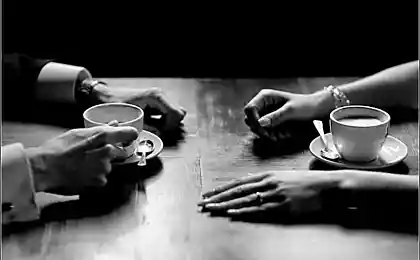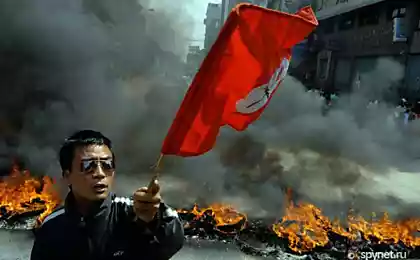1887
The Sino-Soviet conflict in the peninsula Damanskii
After the Paris Peace Conference in 1919 there was a provision stating that the boundaries between the states should, as a rule (but not necessarily), held in the middle of the main channel of the river. But it provides an exception like the border of one of the banks, such as the border has developed historically - the contract or if one side is colonized second shore before it began to colonize other.

Furthermore, international treaties and agreements are not retroactive. Nevertheless, in the late 1950s, when China, seeking to increase its international influence in conflict with Taiwan (1958) and participated in the border war with India (1962), the Chinese used the new provisions of the boundaries, as a reason for the revision of the Soviet -Chinese border.

Owner of the USSR was ready to go for it, in 1964, was consulted on the border, but was inconclusive.

Due to ideological differences during the Cultural Revolution in China and after the Prague Spring of 1968, when the Chinese authorities announced that the Soviet Union embarked on a path of "socialist imperialism", particularly strained relations.

Damanskii Island, a member of the Pozharsky District of Primorsky Krai is on the Chinese side of the main channel of the Ussuri. Its dimensions are 1500-1800 meters from north to south and 600-700 meters from west to east (an area of about 0, 74 square kilometers).
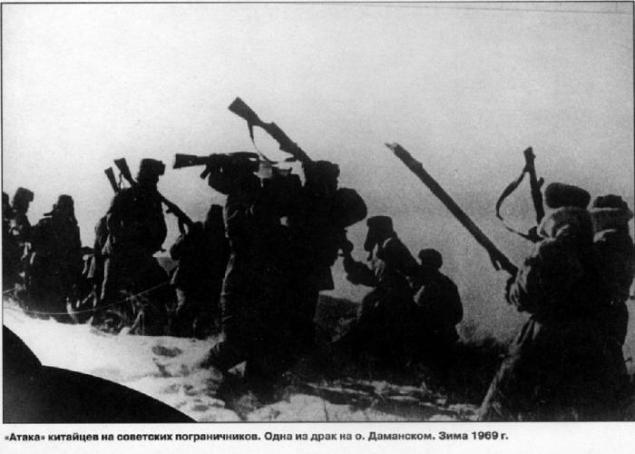
During floods the island completely disappears under water and no economic value is not.

Since the beginning of 1960 the situation in the area of the island escalated. According to the Soviet side, a group of civilians and military personnel began to systematically violate the border regime and go to Soviet territory, where every time the border guards to turn out without the use of weapons.

At first, the territory of the USSR on the orders of the Chinese authorities came peasants and deliberately engaged in economic activities there: meadow and grazing, stating that they are in the Chinese territory.

The number of such provocations has risen sharply: in 1960 there were 100, in 1962 - more than 5000. Then they started to attack the Red Guards on the border patrols.
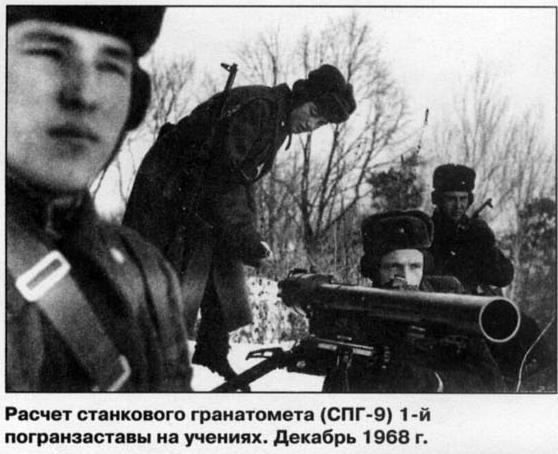
The score in this event went to thousands, all of them use up to several hundred people.

January 4, 1969 on the island of Kirkinskii (Tsilitsindao) was held with the participation of the Chinese provocation 500.
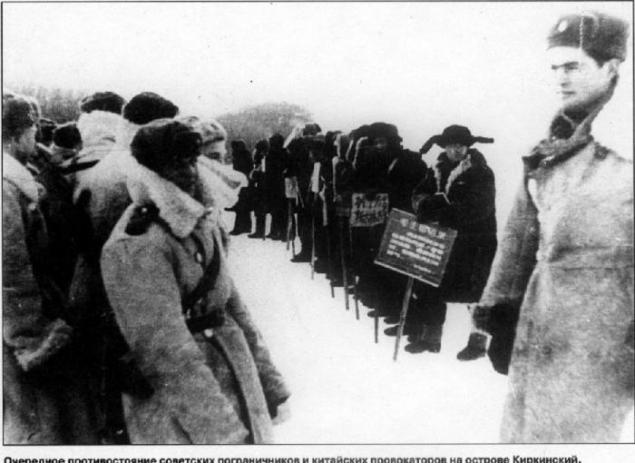
According to the Chinese version of events, the Soviet border guards themselves staged provocation and beat the Chinese citizens involved in economic activity, where they have always done.

During the incident, they used Kirkinskii BTR to displace civilians and crushed four of them, and February 7, 1969 made several automatic single shots in the direction of the Chinese frontier.

However, many times, it was noted that none of these clashes, on whose fault would they occur, could result in a serious armed conflict without the approval of authorities. The assertion that the events around the island Damanskii 2 and 15 March are the result of a carefully planned action by the Chinese side is now the most widespread; including directly or indirectly recognized by many Chinese historians.

For example, Lee Danhuey writes that in 1968-1969 years of the Soviet response to the provocations of the directive limited the CPC Central Committee, only 25 January 1969 were allowed to plan a "retaliatory military actions" in the island by the three Sino-Soviet mouth. On February 19, it agreed to the General Staff and the Ministry of Foreign Affairs of China.
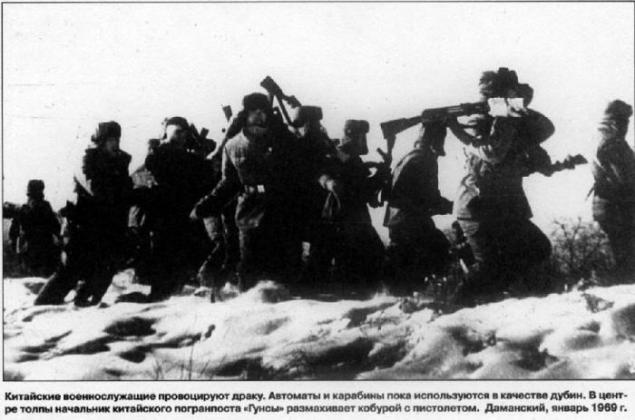
Events March 1-2 and the following week
On the night of 1 to 2 March 1969 about 300 Chinese soldiers in winter camouflage, armed with AK and SKS carbine, crossed to the Sino-Soviet and lay on the higher western coast of the island.

The group remained unnoticed until 10:40, when the 2nd outpost "Lower Mikhailovka" 57th Iman Border Detachment received the report from the observation post that moves in the direction Damansky group of armed men of up to 30 people. On the scene had left 32 Soviet border guards, including the head of the outpost, Senior Lieutenant Ivan Strelnikov on GAZ-69 and GAZ-63 and one BTR-60PB. At 11:10 they arrived at the southern tip of the island. The border guards under the command of Strelnikova divided into two groups. The first group, under the command Strelnikova went to a group of Chinese soldiers who were standing on the ice south-west of the island.

The second group under the command of Sergeant Vladimir Rabovicha had to cover a group of Strelnikova to the southern coast of the island. Strelnikov protested the violation of the border and demanded that Chinese troops leave the territory of the USSR. One of the Chinese troops lifted his hand up, that was the signal to open fire on the Chinese side and Rabovicha Strelnikova groups. The beginning of an armed provocation was able to capture on film the ordinary military photojournalist Nikolai Petrov. Strelnikov, and followed him guards were killed immediately, and the battle was lost in the fleeting department of border guards under the command of Sergeant Rabovicha. Command of surviving guards took the sergeant Yuriy Babanskii.
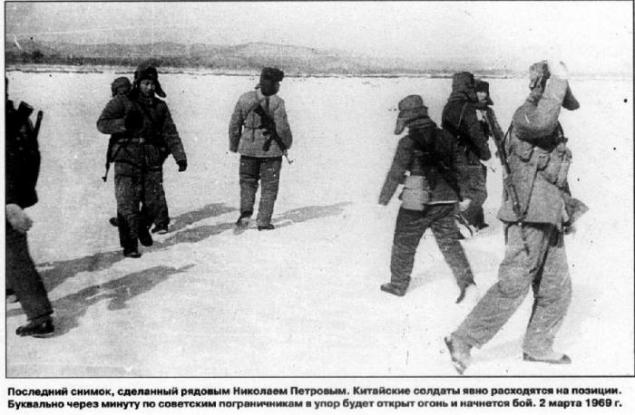
After receiving a report about the shooting on the island, the head of the neighboring 1st outposts "Kulebyakiny hill" Senior Lieutenant Vitaly Bubenin left on the BTR-60PB and GAZ-69 with 20 fighters to help. In the battle Bubenin was wounded and sent to the rear BTR Chinese, skirting the ice northern tip of the island, but soon the APC was hit and Bubenin decided to go out with his men to the Soviet coast. Reaching BTR deceased Strelnikova and reseeding in a group Bubenin moved along the positions of the Chinese and destroyed their command post. Those started to retreat.

In combat, March 2 killed 31 Soviet border guards, 14 were injured. Loss of the Chinese side (according to the Commission of the KGB) were 247 people killed

About 12:00 to the Sino-Soviet helicopter arrived with the command of frontier Iman and his chief Colonel DV Leonov and reinforcements from nearby outposts. On the Sino-Soviet border guards came out reinforced outfits, and in the rear was deployed 135th motorized rifle division of the Soviet Army with artillery and multiple rocket launchers installations BM-21 "Grad". The Chinese side was preparing for hostilities 24th Infantry Regiment numbering 5,000.

March 3 in Beijing held a demonstration near the Soviet Embassy. On March 4, the Chinese newspaper "People's Daily" and "Tsefansiungpao» (解放军报) published an editorial, "Down with the new kings!", Places the blame for the incident on the Soviet troops, who, according to the author, "move-revisionist clique of renegades brazenly invaded the island on the river Usulitszyan Chzhenbaodao in Heilongjiang province of our country, opened the gun and cannon fire on the border guards to the People's Liberation Army of China, killing and wounding many of them. " The Soviet "Pravda" newspaper on the same day an article "Shame provocateurs!" According to the author, "the Chinese armed detachment crossed the Soviet state border and went to the Sino-Soviet. According to Soviet border guards guarding the area, the Chinese side had suddenly opened fire. There are dead and wounded. "March 7 have the Chinese Embassy in Moscow was subjected to picketing. The protesters also pelted the building with ink bubbles.
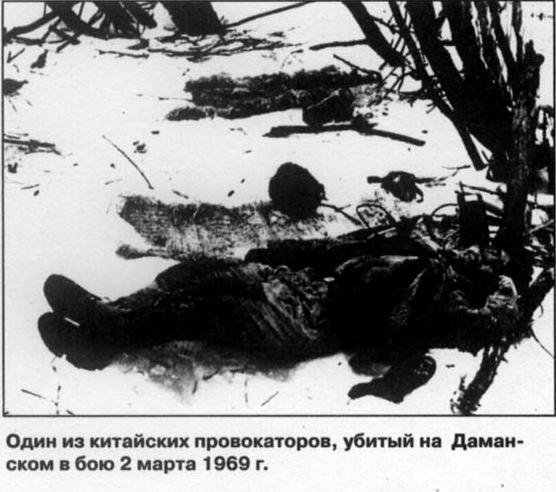
Events March 14-15
March 14 at 15:00 we received an order to remove the unit guards the island. Immediately after the withdrawal of Soviet border guards began to occupy the island of Chinese soldiers. In response, 8 armored personnel carriers under the command of the chief of the group motomanevrennoy 57th border guard lieutenant colonel E. Yanshina in battle array marched towards the Sino-Soviet; Chinese retreated to a beach.

At 20:00 on March 14 border guards were ordered to occupy the island. That night there Yanshina entrenched group of 60 people for 4 APC. On the morning of March 15 after leading on both sides of the broadcast over loudspeakers at 10:00 from 30 to 60 barrels of Chinese artillery and mortars began shelling the Soviet position, and three companies of Chinese infantry went on the offensive. A fight broke out.

At 20:00 on March 14 border guards were ordered to occupy the island. That night there Yanshina entrenched group of 60 people for 4 APC. On the morning of March 15 after leading on both sides of the broadcast over loudspeakers at 10:00 from 30 to 60 barrels of Chinese artillery and mortars began shelling the Soviet position, and three companies of Chinese infantry went on the offensive. A fight broke out.
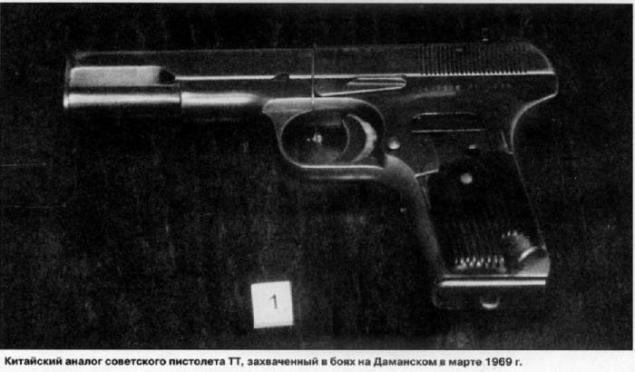
From 400 to 500 Chinese soldiers took up positions at the south end of the island and prepared to go to the rear to Yanshin. Two APCs his group were shot down, communication is spoiled. Four T-62 under the command of D. Leonova attacked the Chinese at the southern tip of the island, but the tank was hit Leonova (according to different versions, a shot from a grenade launcher RPG-2, or blown up by anti-tank mine), and the Leonov was shot sniper Chinese while trying to leave the burning car.

It aggravates the situation is that Leonov did not know the island and because of this the Soviet tanks came too close to the Chinese positions. However, the cost of losing the Chinese were not allowed to leave the island.

Two hours later, having spent ammunition, Soviet border guards still were forced to withdraw from the island. It became clear that entered into combat strength is not enough, and far superior to the Chinese border guards troops numerically. At 17:00 in a critical situation, in violation of the instructions of the Politburo not to enter into conflict, Soviet troops, by order of the Commander of the Far Eastern Military District Oleg Losik fire was opened from the secret at the moment multiple launch rocket systems (MLRS) "Grad". < br />
The shells have destroyed most of the material resources of the Chinese groups and the military, including reinforcement, mortars, piles of shells. At 17:10 the attack went motorized infantry of the 2nd infantry battalion 199th Motorized Rifle Regiment and border guards under the command of Lieutenant Colonel and Lieutenant Colonel Smirnov Konstantinova with the aim of finally crush the resistance of the Chinese troops. The Chinese began to retreat from their positions. Approximately 19.00 "alive" several firing points, were made after the three new attacks, but they were repulsed.

Soviet troops withdrew back to your bank, and China is no longer undertook large-scale hostilities on the section of the state border.
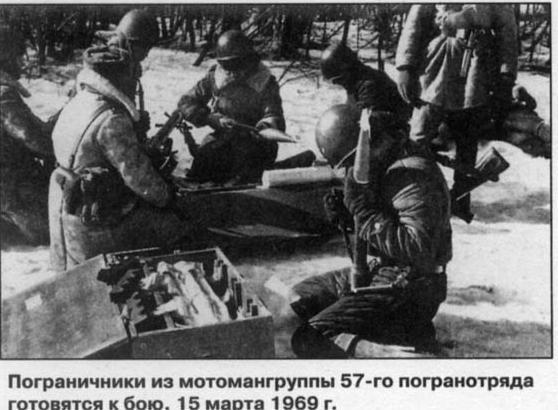
Total in clashes Soviet troops lost in killed and died of wounds 58 people (including 4 officers), wounded 94 people (including 9 officers).
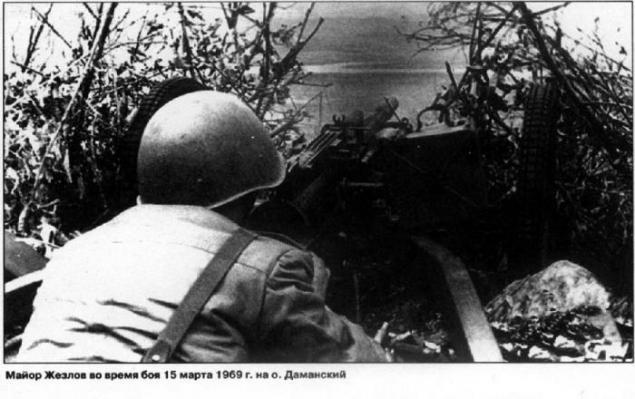
Irreversible loss of the Chinese side are still classified information and form according to various estimates from 100-150 to 800 or even 3,000. The county Baoqing is a memorial cemetery where the remains of 68 Chinese soldiers killed 2 and 15 March 1969. Information from the Chinese defector, suggests that there are other disposal.

For his heroism five soldiers were awarded the title Hero of the Soviet Union Colonel D. Leone (posthumously), Senior Lieutenant I. Strelnikov (posthumously), Junior Sergeant V. Orekhov (posthumously), Senior Lieutenant V. Bubenin, Sergeant Yu Babanskii. < br />
Many guards and soldiers of the Soviet Army awarded the state awards: 3 - Orders of Lenin, 10 - Orders of the Red Banner, 31 - Order of the Red Star, 10 - Order of Glory III degree, 63 - with medals "For Courage", 31 - the medal "For Service in Battle" .
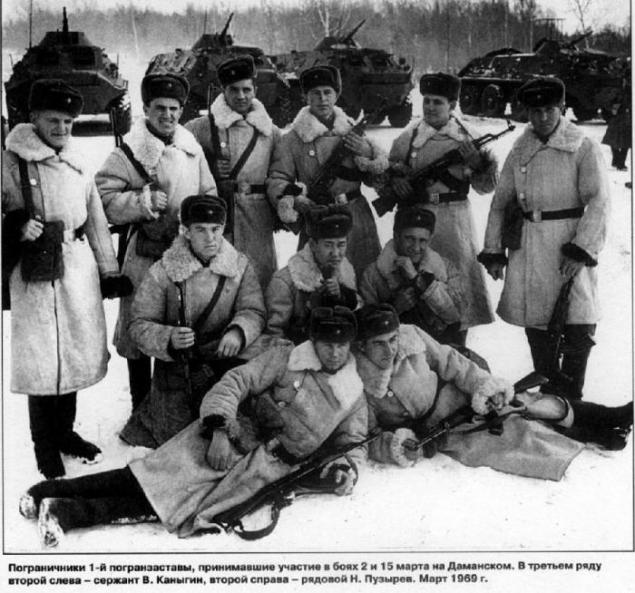



The settlement and the consequences
Padded T-62 Soviet soldiers could not return because of the constant attacks of the Chinese. The attempt to destroy it with mortars was not successful, and the tank fell through the ice. Subsequently, the Chinese were able to pull him to his bank and now it stands at the Beijing Military Museum of.
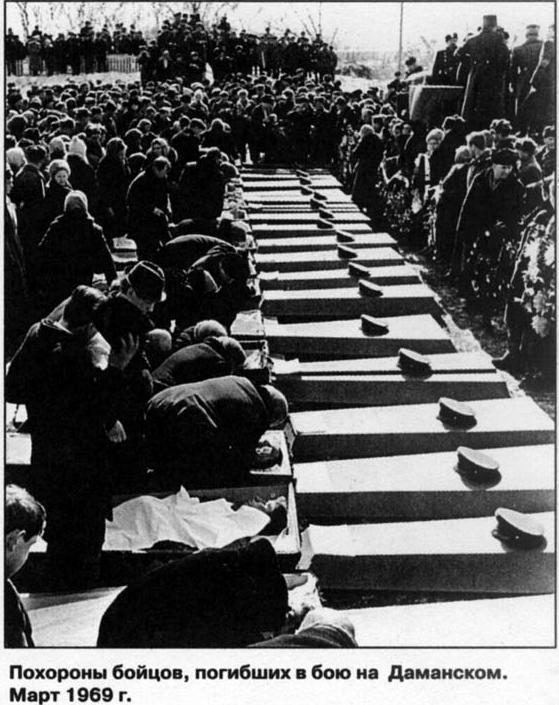
After the ice melted the exit of Soviet border guards on the Sino-Soviet proved difficult, and attempts to prevent its capture by the Chinese had sniper and machine-gun fire. September 10, 1969 was ordered to cease fire, apparently to create a favorable background of negotiations, which began the next day at Beijing airport.

Immediately Damanskii Kirkinskii and occupied the Chinese armed forces.
September 11 in Beijing, Chairman of the USSR Council of Ministers Kosygin, who was returning from the funeral of Ho Chi Minh, and the Premier of the State Council of China Zhou Enlai agreed to cease hostile actions and that the troops remain in the position. In fact, it meant the transfer Damansky China.
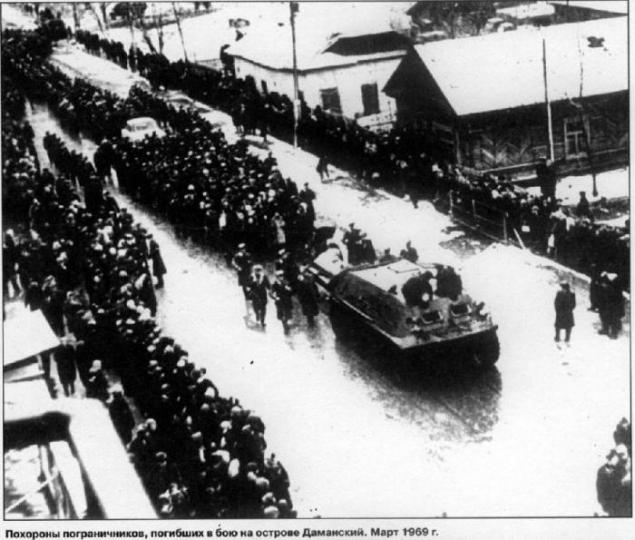
October 20, 1969 held new talks between the governments of the USSR and China, to reach an agreement on the need to revise the Soviet-Chinese border. Then held a number of talks in Beijing and Moscow, and in 1991 the island Damanskii finally went to China.

Furthermore, international treaties and agreements are not retroactive. Nevertheless, in the late 1950s, when China, seeking to increase its international influence in conflict with Taiwan (1958) and participated in the border war with India (1962), the Chinese used the new provisions of the boundaries, as a reason for the revision of the Soviet -Chinese border.

Owner of the USSR was ready to go for it, in 1964, was consulted on the border, but was inconclusive.

Due to ideological differences during the Cultural Revolution in China and after the Prague Spring of 1968, when the Chinese authorities announced that the Soviet Union embarked on a path of "socialist imperialism", particularly strained relations.

Damanskii Island, a member of the Pozharsky District of Primorsky Krai is on the Chinese side of the main channel of the Ussuri. Its dimensions are 1500-1800 meters from north to south and 600-700 meters from west to east (an area of about 0, 74 square kilometers).

During floods the island completely disappears under water and no economic value is not.

Since the beginning of 1960 the situation in the area of the island escalated. According to the Soviet side, a group of civilians and military personnel began to systematically violate the border regime and go to Soviet territory, where every time the border guards to turn out without the use of weapons.

At first, the territory of the USSR on the orders of the Chinese authorities came peasants and deliberately engaged in economic activities there: meadow and grazing, stating that they are in the Chinese territory.

The number of such provocations has risen sharply: in 1960 there were 100, in 1962 - more than 5000. Then they started to attack the Red Guards on the border patrols.

The score in this event went to thousands, all of them use up to several hundred people.

January 4, 1969 on the island of Kirkinskii (Tsilitsindao) was held with the participation of the Chinese provocation 500.

According to the Chinese version of events, the Soviet border guards themselves staged provocation and beat the Chinese citizens involved in economic activity, where they have always done.

During the incident, they used Kirkinskii BTR to displace civilians and crushed four of them, and February 7, 1969 made several automatic single shots in the direction of the Chinese frontier.

However, many times, it was noted that none of these clashes, on whose fault would they occur, could result in a serious armed conflict without the approval of authorities. The assertion that the events around the island Damanskii 2 and 15 March are the result of a carefully planned action by the Chinese side is now the most widespread; including directly or indirectly recognized by many Chinese historians.

For example, Lee Danhuey writes that in 1968-1969 years of the Soviet response to the provocations of the directive limited the CPC Central Committee, only 25 January 1969 were allowed to plan a "retaliatory military actions" in the island by the three Sino-Soviet mouth. On February 19, it agreed to the General Staff and the Ministry of Foreign Affairs of China.

Events March 1-2 and the following week
On the night of 1 to 2 March 1969 about 300 Chinese soldiers in winter camouflage, armed with AK and SKS carbine, crossed to the Sino-Soviet and lay on the higher western coast of the island.

The group remained unnoticed until 10:40, when the 2nd outpost "Lower Mikhailovka" 57th Iman Border Detachment received the report from the observation post that moves in the direction Damansky group of armed men of up to 30 people. On the scene had left 32 Soviet border guards, including the head of the outpost, Senior Lieutenant Ivan Strelnikov on GAZ-69 and GAZ-63 and one BTR-60PB. At 11:10 they arrived at the southern tip of the island. The border guards under the command of Strelnikova divided into two groups. The first group, under the command Strelnikova went to a group of Chinese soldiers who were standing on the ice south-west of the island.

The second group under the command of Sergeant Vladimir Rabovicha had to cover a group of Strelnikova to the southern coast of the island. Strelnikov protested the violation of the border and demanded that Chinese troops leave the territory of the USSR. One of the Chinese troops lifted his hand up, that was the signal to open fire on the Chinese side and Rabovicha Strelnikova groups. The beginning of an armed provocation was able to capture on film the ordinary military photojournalist Nikolai Petrov. Strelnikov, and followed him guards were killed immediately, and the battle was lost in the fleeting department of border guards under the command of Sergeant Rabovicha. Command of surviving guards took the sergeant Yuriy Babanskii.

After receiving a report about the shooting on the island, the head of the neighboring 1st outposts "Kulebyakiny hill" Senior Lieutenant Vitaly Bubenin left on the BTR-60PB and GAZ-69 with 20 fighters to help. In the battle Bubenin was wounded and sent to the rear BTR Chinese, skirting the ice northern tip of the island, but soon the APC was hit and Bubenin decided to go out with his men to the Soviet coast. Reaching BTR deceased Strelnikova and reseeding in a group Bubenin moved along the positions of the Chinese and destroyed their command post. Those started to retreat.

In combat, March 2 killed 31 Soviet border guards, 14 were injured. Loss of the Chinese side (according to the Commission of the KGB) were 247 people killed

About 12:00 to the Sino-Soviet helicopter arrived with the command of frontier Iman and his chief Colonel DV Leonov and reinforcements from nearby outposts. On the Sino-Soviet border guards came out reinforced outfits, and in the rear was deployed 135th motorized rifle division of the Soviet Army with artillery and multiple rocket launchers installations BM-21 "Grad". The Chinese side was preparing for hostilities 24th Infantry Regiment numbering 5,000.

March 3 in Beijing held a demonstration near the Soviet Embassy. On March 4, the Chinese newspaper "People's Daily" and "Tsefansiungpao» (解放军报) published an editorial, "Down with the new kings!", Places the blame for the incident on the Soviet troops, who, according to the author, "move-revisionist clique of renegades brazenly invaded the island on the river Usulitszyan Chzhenbaodao in Heilongjiang province of our country, opened the gun and cannon fire on the border guards to the People's Liberation Army of China, killing and wounding many of them. " The Soviet "Pravda" newspaper on the same day an article "Shame provocateurs!" According to the author, "the Chinese armed detachment crossed the Soviet state border and went to the Sino-Soviet. According to Soviet border guards guarding the area, the Chinese side had suddenly opened fire. There are dead and wounded. "March 7 have the Chinese Embassy in Moscow was subjected to picketing. The protesters also pelted the building with ink bubbles.

Events March 14-15
March 14 at 15:00 we received an order to remove the unit guards the island. Immediately after the withdrawal of Soviet border guards began to occupy the island of Chinese soldiers. In response, 8 armored personnel carriers under the command of the chief of the group motomanevrennoy 57th border guard lieutenant colonel E. Yanshina in battle array marched towards the Sino-Soviet; Chinese retreated to a beach.

At 20:00 on March 14 border guards were ordered to occupy the island. That night there Yanshina entrenched group of 60 people for 4 APC. On the morning of March 15 after leading on both sides of the broadcast over loudspeakers at 10:00 from 30 to 60 barrels of Chinese artillery and mortars began shelling the Soviet position, and three companies of Chinese infantry went on the offensive. A fight broke out.

At 20:00 on March 14 border guards were ordered to occupy the island. That night there Yanshina entrenched group of 60 people for 4 APC. On the morning of March 15 after leading on both sides of the broadcast over loudspeakers at 10:00 from 30 to 60 barrels of Chinese artillery and mortars began shelling the Soviet position, and three companies of Chinese infantry went on the offensive. A fight broke out.

From 400 to 500 Chinese soldiers took up positions at the south end of the island and prepared to go to the rear to Yanshin. Two APCs his group were shot down, communication is spoiled. Four T-62 under the command of D. Leonova attacked the Chinese at the southern tip of the island, but the tank was hit Leonova (according to different versions, a shot from a grenade launcher RPG-2, or blown up by anti-tank mine), and the Leonov was shot sniper Chinese while trying to leave the burning car.

It aggravates the situation is that Leonov did not know the island and because of this the Soviet tanks came too close to the Chinese positions. However, the cost of losing the Chinese were not allowed to leave the island.

Two hours later, having spent ammunition, Soviet border guards still were forced to withdraw from the island. It became clear that entered into combat strength is not enough, and far superior to the Chinese border guards troops numerically. At 17:00 in a critical situation, in violation of the instructions of the Politburo not to enter into conflict, Soviet troops, by order of the Commander of the Far Eastern Military District Oleg Losik fire was opened from the secret at the moment multiple launch rocket systems (MLRS) "Grad". < br />

The shells have destroyed most of the material resources of the Chinese groups and the military, including reinforcement, mortars, piles of shells. At 17:10 the attack went motorized infantry of the 2nd infantry battalion 199th Motorized Rifle Regiment and border guards under the command of Lieutenant Colonel and Lieutenant Colonel Smirnov Konstantinova with the aim of finally crush the resistance of the Chinese troops. The Chinese began to retreat from their positions. Approximately 19.00 "alive" several firing points, were made after the three new attacks, but they were repulsed.

Soviet troops withdrew back to your bank, and China is no longer undertook large-scale hostilities on the section of the state border.

Total in clashes Soviet troops lost in killed and died of wounds 58 people (including 4 officers), wounded 94 people (including 9 officers).

Irreversible loss of the Chinese side are still classified information and form according to various estimates from 100-150 to 800 or even 3,000. The county Baoqing is a memorial cemetery where the remains of 68 Chinese soldiers killed 2 and 15 March 1969. Information from the Chinese defector, suggests that there are other disposal.

For his heroism five soldiers were awarded the title Hero of the Soviet Union Colonel D. Leone (posthumously), Senior Lieutenant I. Strelnikov (posthumously), Junior Sergeant V. Orekhov (posthumously), Senior Lieutenant V. Bubenin, Sergeant Yu Babanskii. < br />
Many guards and soldiers of the Soviet Army awarded the state awards: 3 - Orders of Lenin, 10 - Orders of the Red Banner, 31 - Order of the Red Star, 10 - Order of Glory III degree, 63 - with medals "For Courage", 31 - the medal "For Service in Battle" .




The settlement and the consequences
Padded T-62 Soviet soldiers could not return because of the constant attacks of the Chinese. The attempt to destroy it with mortars was not successful, and the tank fell through the ice. Subsequently, the Chinese were able to pull him to his bank and now it stands at the Beijing Military Museum of.

After the ice melted the exit of Soviet border guards on the Sino-Soviet proved difficult, and attempts to prevent its capture by the Chinese had sniper and machine-gun fire. September 10, 1969 was ordered to cease fire, apparently to create a favorable background of negotiations, which began the next day at Beijing airport.

Immediately Damanskii Kirkinskii and occupied the Chinese armed forces.
September 11 in Beijing, Chairman of the USSR Council of Ministers Kosygin, who was returning from the funeral of Ho Chi Minh, and the Premier of the State Council of China Zhou Enlai agreed to cease hostile actions and that the troops remain in the position. In fact, it meant the transfer Damansky China.

October 20, 1969 held new talks between the governments of the USSR and China, to reach an agreement on the need to revise the Soviet-Chinese border. Then held a number of talks in Beijing and Moscow, and in 1991 the island Damanskii finally went to China.






